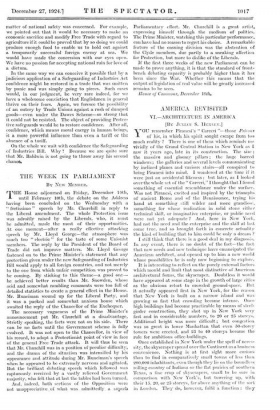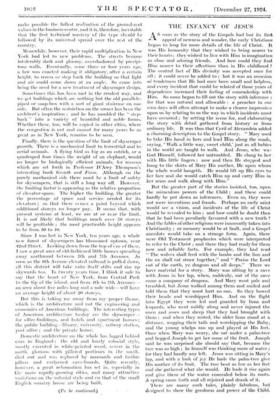AMERICA REVISITED
you remember Piranesi's " Careen "—those Prisons of his, in which his spirit sought escape from too much reality ? There is one of them which reminds me vividly of the Grand Central Station in New York as I saw it years ago, late in its construction. The size ; the massive and gloomy pillars ; the huge barred windows ; the galleries and several levels communicating by inclined planes and various stairs—all conspired to bring Piranesi into mind. I wondered at the time if it were just an accidental likeness ; but later, as I looked over the whole set of the " Careeri," I thought that I found something of essential resemblance under the surface. Was not Piranesi, excited and inspired by the triumphs of ancient Rome and of the Renaissance, trying his hand at something still wilder and more grandiose, something for whose realization in . solid stone either teclmical skill, or imaginative enterprise, or public need were not yet adequate ? And, here in New York, had not the need and the enterprise and the skill at last conic true, and so brought forth in concrete actuality the kind of building that to him could be only a dream ?
I still think that there is a good deal in my diagnosis. In any event, there is no doubt of the fact—the fact that new needs and new technique have emancipated the American architect, and opened up to him a .new world whose possibilities lie is only now beginning to explore.
It is interesting to reflect on the purely external factors which mould and limit that most distinctive of American architectural forms, the skyscraper. Doubtless it would have appeared at some stage in the growth of large cities as the obvious retort to crowded ground-space. But it actually appeared first in New York, for the reason that New York is built on a narrow island and was growing so fast that crowding became intense. Once high buildings had become practicable by means of steel- girder construction, they shot up in New York very fast and in considerable numbers, to 20 or 25 storeys. Additional height was more difficult ; but congestion was so great in lower Manhattan that even 50-storey towers were erected, and 25 to 40 storeys became the rule for ambitious office-buildings.
Once established in New York under the spell of neces- sity, the skyscraper spread over the Continent as a business convenience. Nothing is at first sight more curious than to find in comparatively small towns of less than 200,000 inhabitants, even though they lie on the boundless rolling country of Indiana or the flat prairies of southern Texas, a fine crop of skyscrapers, small to be sure in comparison with New York's, but towering up, with their 15, 20, or 25 storeys, far above anything of the sort in London. They do, however, fulfil a function ; they make possible the fullest realization of the ground-rent values in the business centre, and it is, therefore, inevitable that the first technical mastery. of the type should be followed by its universal spread over the rest of the country. • Meanwhile, however, their rapid multiplication in New York had led to new problems. The streets became- intolerably dark and gloomy, overshadowed by precipi- tous walls. Eventually, some three or four years ago; a law was enacted making it •obligatory, after a certain height, to recess or step back the building so that light and air could come down at an angle. So came into being the need for a new treatment of skyscraper design.
Sometimes this has been met in the crudest -way, and we get buildings which arc nothing but the old parallele- piped or soap-box with a sort of giant staircase on one side. But often the restriction on the owner has been the architect's inspiration ; and he has moulded the " step- back " into a variety of beautiful and noble forms.
Whether these, too, will be copied in other cities, where the congestion is not and cannot for many years be as great as in New York, remains to be seen.
• Finally, there is the question of the limit of skyscraper. growth: There is a mechanical liMit to terrestrial and to" aerial animals. A flying bird as big as an ostrich, or a quadruped four times the weight of an elephant, would no longer be biologically efficient animals, for reasons which are set forth in Professor D'Arcy Thompson's. interesting book Grraeth and Form. Although on the purely mechanical side there must be a limit of safety- for skyscrapers, that is still a long way off. However, the limiting factor is appearing as the relative.proportion of elevator-space. The higher the building, the greater the percentage of space and service needed for its elevators ; so that there (Tines a. point beyond which additional storeys no longer pay. It seems that, with present systems at least, we are at or near the limit. It is not likely that buildings much over 50 storeys will be profitable ; the most practicable height appears to be from 30 to 40.
Since I was last in New York, ten years ago, a whole new forest of skyscrapers has blossomed uptown, near 42nd Street. Looking down from the top of cue of these, I saw a great area of old-fashioned little houses spreading away northward between 5th and 7th Avenues. As soon as the 6th Avenue elevated railroad is pulled down, all this district will take unto itself stilts and rise up Skywards too. In twenty years time, I think it safe to say that the heart of New York, from Central Park to the tip of the island, and from 4th to 7th Avenues-- an area about five miles long and a mile wide—will have an average height of about 20 storeys.
- But this is taking me away from my proper theme, which is the architecture and not the engineering and economies of American buildings. The interesting types of American architecture to-day arc the skyscraper— for office-buildings, and hotels and apartment houses ; the public building—library, university, railway station, post office ; and the private house.
Domestic architecture on the whole has lagged behind Qurs in England ; the old and lovely colonial style, mostly executed in white-painted wood, severe in the north, glorious with pillared . porticoes in the south, died out and was replaced by mansards and Gothic pillars and curlycued cave-boards. Quite recently, however, a great reformation has set in, especially in the more rapidly-growing cities, and many attractive variations on the colonial style and on that of the small English country house are being built.
(To be continued')



























 Previous page
Previous page